

Music Theory/Chord Structures. A chord structure, also called a chord progression or harmonic progression, helps indicate where the melody should go.
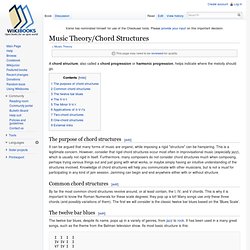
The purpose of chord structures[edit] It can be argued that many forms of music are organic, while imposing a rigid "structure" can be hampering. This is a legitimate concern. However, consider that rigid chord structures occur most often in improvisational music (especially jazz), which is usually not rigid in itself. Furthermore, many composers do not consider chord structures much when composing, perhaps trying various things out and just going with what works, or maybe simply having an intuitive understanding of the structures involved.
Music Theory/Finding the Key and Mode of a Piece. Identifying keys[edit] Finding the proper key is a matter of finding the I note, then finding what mode the notes seem to follow.
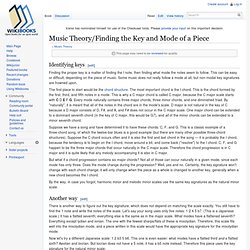
This can be easy or difficult, depending on the piece of music. Some music does not really follow a mode at all, but non-modal key signatures are frowned upon. The first place to start would be the chord structure. The most important chord is the I chord. Suppose we have a song and have determined it to have these chords: C, F, and G. Harmonic Functions - The II and VII Degrees. Acorde. Intervalos musicales, mostrados sobre el pentagrama con la nota do como tono fundamental.
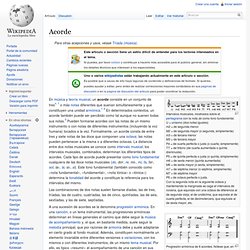
U = unísono (dos notas iguales) m2 = de segunda menor M2 = de segunda mayor (o segunda, simplemente) m3 = de tercera menor M3 = de tercera mayor P4 = de cuarta perfecta o justa (o cuarta, simplemente) TT = de tritono (de cuarta aumentada o quinta disminuida) P5 = de quinta perfecta o justa (o quinta, simplemente) m6 = de sexta menor (quinta aumentada) M6 = de sexta mayor (o sexta, simplemente) m7 = de séptima menor (o séptima, simplemente) M7 = de séptima mayor P8 = de octava perfecta o justa.
Con la segunda nota en la siguiente octava y manteniendo la marginada se caga el intervalos de novena, que equivale con una octava de diferencia al de segunda vieja, el de undécima, que equivale al de cuarta perfecta, el de decimotercera, que equivale al de sexta mayor, etc. Progresión armónica de 6 acordes. Intervalos y sus secuencias[editar] Intervalos en la notación anglosajona[editar] Tipos de tríadas. Teoría - Music Theory Web.
How to construct chords - Piano Clues: Free tips and lessons for playing piano, organ and electronic keyboard. You don’t need a “1000 Chords Dictionary” to be able to read and play chords.
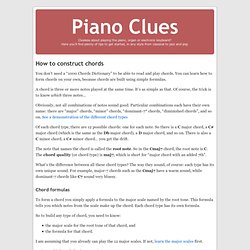
You can learn how to form chords on your own, because chords are built using simple formulas. A chord is three or more notes played at the same time. It’s as simple as that. Of course, the trick is to know which three notes… Obviously, not all combinations of notes sound good. Of each chord type, there are 12 possible chords: one for each note. The note that names the chord is called the root note. Ricci Adams' Musictheory.net. List of chord progressions. Scales and emotions. See also a post about making chords from scales.

So maybe you want to write a song or an instrumental in a particular mood or style, and you’re feeling overwhelmed by all the scales. Here’s a handy guide to the commonly used scales in Western pop, rock, jazz, blues and so on. Click each image to play the scale right in your browser with the aQWERTYon. Learning and Loving Music Theory. Kelvin, You actually caught a mistake on the roman numerals!
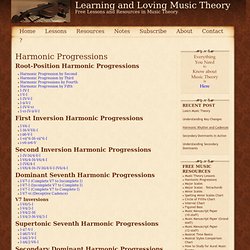
Thanks, I’ll have to fix that. The first and last chords of the progression are not 7th chords. Somehow I inadvertently typed “I7″ on the first chord of all the major keys. (Notice that I didn’t do that for the minor keys.) In the classical tradition, for the sake of stability, the first and last chords of a circle-of-fifths progression are usually triads, not 7th chords. Harmonic Sequences Part 2. Basic Music Theory Overview. Circle of 5ths text. Find the Chords in a Scale Once more, the key of C is our reference.
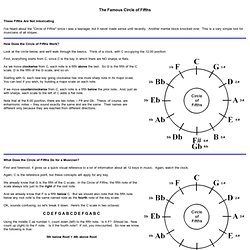
Because the Circle of Fifths can help us name the notes in any major scale, it can also show us the chords in a major chord scale. Here's how: 50s progression. 50s progression in C, ending with C ( Play ) The progression, represented in Roman numeral analysis, is: I-vi-IV-V.
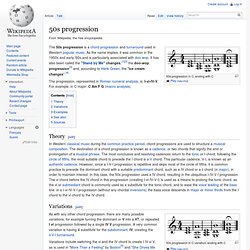
For example, in C major: C Am F G (macro analysis). Theory[edit] Variations[edit] Properties of musical modes. Modern Dorian mode on C Play Early Greek treatises on music do not use the term "mode" (which comes from Latin), but do describe three interrelated concepts that are related to the later, medieval idea of "mode": (1) scales (or "systems"), (2) tonos—pl. tonoi—(the more usual term used in medieval theory for what later came to be called "mode"), and (3) harmonia (harmony)—pl. harmoniai—this third term subsuming the corresponding tonoi but not necessarily the converse (Mathiesen 2001a, 6(iii)(e)).
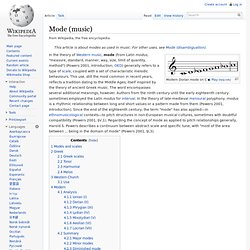
Greek Dorian octave species in the enharmonic genus, showing the two component tetrachords Play. What is an Interval? Printable Staff Paper. Whatever you are a music teacher, a composer or a simple musician for sure you may need some good quality staff paper.

You can choose to buy it at the music store or at the stationer's shop or You can print it by yourself free and save your money and time! If you want to print staff paper of your own Blank Sheet Music .net is the best way to get it quickly and free. The site offers a wide variety of settings for thousand different formats of blank staff paper: Chord Families. This tutorial introduces the idea of Chord Families. To get the most out of this, you need to be comfortable with the theory behind chord construction.
Make sure that you've read the following tutorials first... The basics of chord construction explained Building 7th chords in major keys Adding some new sounds to chord progressions using suspended chords ...and this should make a lot more sense. You may also find that the introduction to the major scale modes is useful background reading as well. I should point out that chord families go a lot further than we are going to cover here - this tutorial limits itself to the types of chords that have been covered in tutorials on this website to date. Kuwait's # 1 community for music,entertainment,events and live shows. The Chord Guide: Pt I – Chord Progressions.
Chord progressions are the canvas on which musicians paint their masterpieces, and it’s a canvas which is a piece of art in itself. A chord progression can be subtle and in the background or it can be blatant and up front; it can be simple and catchy, or it can be technical and complex, it can stay in one key or it can change like the seasons. In any of these cases a chord progression is what drives the song as it literally shapes the music that accompanies it. Chord progressions are like a cozy home where melody and rhythm can kick their feet up. All the songwriting giants, like John Lennon, Paul McCartney, George Harrison, and Bob Dylan, to name a few, have/had a tremendous knowledge of the art of the chord progression. I’m not going to promise you tremendous knowledge, but I will offer you a good head start in the way of making your own music – in an easily digestible chunk to boot. Guitar in DADGAD-Tuning (D, A, D G A D')]
Chord Calculator. Harmonic Functions - Augmented Sixths. We will start by transforming the iv degree chord of the A minor key into an augmented sixth chord. Intervallic Techniques.